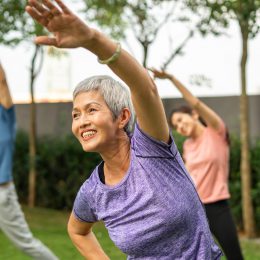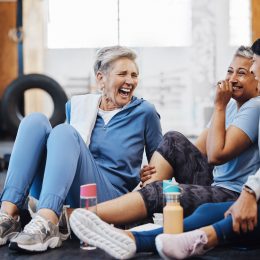Not Motivated to Exercise? Do This
Follow these three simple steps to get in the groove—and maybe even look forward to your workouts.

You know all the great reasons to exercise. It can help ward off chronic disease, keep your muscles and bones strong, boost happiness, and even help you stay social.
But if you still struggle to lace up your sneakers on most days, you’re not alone.
Among adults ages 50 and older, 28 percent are inactive, meaning they are not physically active beyond the basic movements needed for daily life, according to the Centers for Disease Control and Prevention. And among adults 75 and up, that number goes up to 35 percent.
One possible explanation: “As you age, you’re not only fighting the normal barriers we all have—convenience, transportation, time, environment, weather, lack of enjoyment—but you’re also adapting to change,” says Stephen Samendinger, Ph.D., an associate professor at Drexel University College of Nursing and Health Professions, whose research focuses on healthy lifestyle motivation.
Your body might feel a bit achier than it used to or your energy levels might take a hit more often than you’d like, he says. These things are completely normal and shouldn’t stop you from being active—but they often still do.
Your goal is to get at least 150 minutes of moderate-intensity aerobic activity each week. That’s two and a half hours, or about the same amount of time you might spend watching a movie. You can break it up into however many shorter sessions you want, and do whatever activity you enjoy—dancing, walking, hiking, or swimming are all great options.
If that seems like a lofty target and you feel your fitness motivation slipping, follow these steps to get back on track—and eventually make exercise a habit.
Step #1: Change the Way You Set Goals (Hint: Smaller Is Better)
Setting goals that are too big can actually impede your fitness motivation, Samendinger says. If you haven’t jogged in a while and tell yourself your first run will last an hour, you might feel overwhelmed when it comes time to hit the pavement. The result? You don’t run at all.
“Your goals should be realistic, manageable, and incremental,” Samendinger says.
That way, you’ll be able to hit milestones along the way, which will build your confidence little by little.
“As your confidence grows, you generally enjoy that thing you’re doing more,” he explains. “As your enjoyment and confidence go up, then your motivation goes up.”
Avoid blanket terms like “I’m going to become fit” or “I’m going to lose weight.” Instead, aim for specific goals like “I’m going to walk for 20 minutes after dinner each day” or “I’m going to lift weights twice per week.”
That way, you can make bigger goals as you progress, which will only push you to keep achieving them. Here’s how to set yourself up for success by setting a smart goal.
Step #2: Find an Activity You Truly Enjoy
You’ve heard this before, but it’s worth repeating. Enjoyment is a huge predictor in whether or not you’ll continue exercising, Samendinger says.
Case in point: When German researchers interviewed men and women about their exercise habits, they found enjoyment was a common factor among people who maintained a regular exercise routine, according to a study in Frontiers in Psychology.
A sense of achievement, mastery, or winning triggered these positive emotions the most, the researchers say. Meeting new friends through their workouts and feeling like they pushed themselves physically were also high on the list.
The results make sense: Exercise should feel rewarding, Samendinger says. And this should stem from wanting to improve yourself, master skills, or develop relationships. Avoid looking at weight loss or food as your primary reward—that can backfire quickly and negatively impact your relationship with exercise, Samendinger says.
Need help finding a workout you enjoy? Check out the best types of exercise for older adults.
Subscribe to our newsletter
It's quick and easy. You could be one of the 13 million people who are eligible.
Already a member? Click to discover our 15,000+ participating locations.
Follow Us
Step #3: Hold Yourself Accountable—or Find Someone Who Will
If you have a hard time motivating yourself, enlist the help of a friend, Samendinger says. Working out with another person—whether it’s your partner, a family member, or a friend—can actually be extremely healthy and helpful, he says.
For instance, if you told a friend you’d go for a hike at 9 a.m. on Saturday, you’ll feel responsible to that person, which will minimize your chances of backing out. Plus, you can set goals together and push each other along the way.
“Of course, your workout buddy should never shame or guilt you into doing something,” Samendinger says. “Your relationship should feel positive and encouraging.”
The key is to find a way to hold yourself accountable. Another option: Join a fitness class, ideally with people your own age like the many classes offered by SilverSneakers.
A recent study in Health Psychology found older adults who attended exercise classes with people in their own age group attended an average of 10 more classes in a 24-week period than their peers in mixed-age classes.
Participating in community events like 5Ks can have a similar effect on your motivation, Samendinger says.
“Once you’re there and around those people, it can really build your confidence and enjoyment,” he says. “And it can also improve the way you look at exercise.”
Take Your Favorite SilverSneakers Classes Online!
SilverSneakers members can access live fitness classes and wellness workshops through SilverSneakers LIVE. See the latest schedule and RSVP for classes here.
Not a member? If you have a Medicare Plan, it may include SilverSneakers—at no additional cost. Check your eligibility instantly here.





